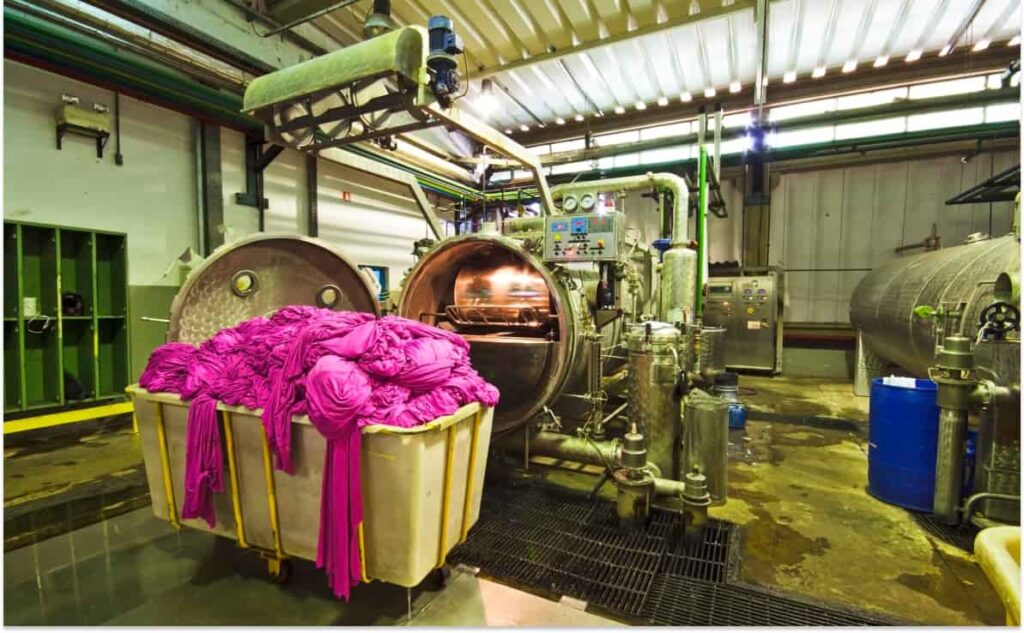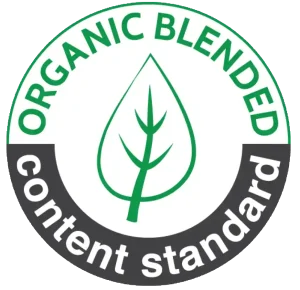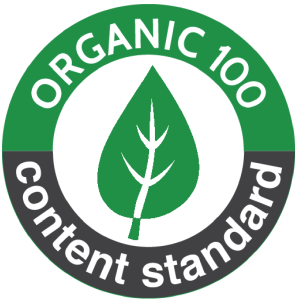Disperse Dyes are a group of non-ionic dyes specifically designed for hydrophobic synthetic fibers, with Polyester (PES) being the primary application. Due to their water-insoluble nature, the dye molecules must be finely ground into ultrafine particles (< 1 micron) and maintained in a stable suspension in an aqueous solution.
In modern industrial textile dyeing, factories have two main options when using Disperse Dyes: Powder Dyes and Liquid Dispersion Dyes. The difference between these two forms is not only physical but also profoundly affects the preparation process, system stability, risk of dyeing defects, and overall operational costs.
This article will deeply analyze the composition, advantages, disadvantages, and optimal applications of both forms, helping engineers and production managers make strategic decisions when working with Disperse Dyes.
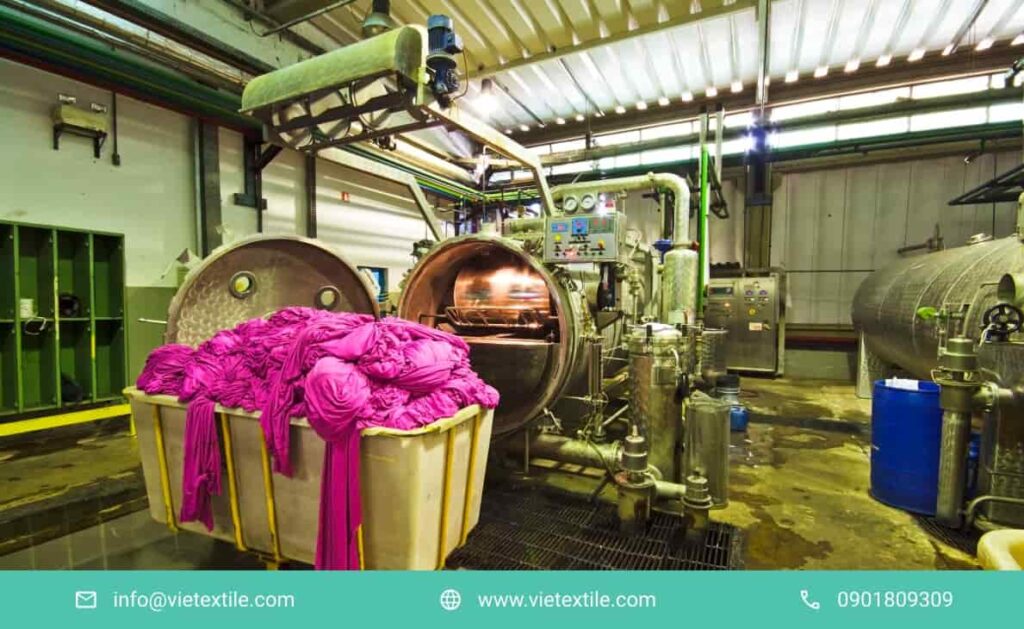
1. Operating Mechanism of Disperse Dyes
Nội dung tóm tắt
ToggleBefore comparing the two forms, it is essential to understand the basic mechanism of Disperse Dyes:
1.1. Chemical Composition
Disperse Dye molecules are small, water-insoluble azo, anthraquinone, or nitroarylamine compounds that do not contain ion-solubilizing groups (such as SO3Na).
1.2. Dyeing Mechanism
- Dissolution: At high dyeing temperatures (120-130C for Polyester), the ultrafine Disperse Dye particles in the solution begin to dissolve, forming single molecules.
- Diffusion: These single molecules diffuse from the solution through the liquid boundary layer near the fiber surface.
- Dissolution in Fiber: Finally, the Disperse Dye molecules penetrate and dissolve into the internal polymer structure of the hydrophobic fiber, creating color.
1.3. Role of the Dispersing Agent
Since Disperse Dyes are insoluble, they always require a dispersing agent (often lignin sulfonates or naphthalene sulfonates derivatives) to keep the particles in suspension. The dispersing agent’s roles are:
- Prevent Flocculation: To create a negatively charged coating (Steric Hindrance) around each particle, preventing them from colliding and sticking together, thus avoiding the formation of large color patches (Tarring) that cause color defects.
- Maintain Particle Size: To ensure the particle size remains at the nanometer/sub-micron level throughout the dyeing process.
2. In-Depth Analysis of Powder Disperse Dyes (Powder Dyes)
Powder Dyes are the traditional and most common form, where dye particles are milled and dried together with the dispersing agent.
2.1. Composition and Preparation Process
- Composition: 30%-50% is pure colorant (Active Ingredient), while the remainder consists of dispersing agents, buffer agents, and wetting agents.
- Preparation: The powder must be dissolved in a small amount of water (usually at 40-60C) and stirred for a certain period (pre-dispersion) before being added to the dye bath.
2.2. Key Advantages of Powder Form
- High Active Ingredient Concentration: The powder form has a higher concentration of colorant compared to the liquid form (as it contains no water solvent), which helps reduce storage volume and transportation costs.
- Stable for Long-Term Storage: The powder form is not at risk of sedimentation, phase separation, or microbial attack over time, provided it is stored in a cool, dry place.
- Lower Unit Cost: In terms of active colorant mass, the powder form is generally more competitively priced than the liquid form due to lower packaging, transport, and stabilizer costs.
2.3. Disadvantages and Operational Challenges
- Dust Hazard: The process of weighing, dosing, and preparing powder Disperse Dyes generates fine dust, posing a hazard to worker health (respiratory) and the working environment.
- Lower Reproducibility: Depends on the operator’s skill during the dissolution process. If the stirring is insufficient or the preparation time is too short, the dye particles may not be fully dispersed, leading to uneven dyeing defects (spotting).
- Not Optimal for Automatic Dosing: The powder form is difficult to integrate into an Automatic Dosing System due to issues with clogging, caking, and moisture sensitivity.
3. In-Depth Analysis of Liquid Disperse Dyes (Liquid Dispersion Dyes)

Liquid Dispersion Dyes are the product of advanced wet milling technology. The dye is directly ground in an aqueous medium together with dispersing agents and stabilizers.
3.1. Composition and Preparation Process
- Composition: Typically contains only 10%-30% pure dye, with the remainder being water, dispersing agents, thickeners, and biocides to ensure storage stability.
- Preparation: The liquid form is poured directly into the mixing tank, requiring only gentle stirring or can be pumped straight into the Dyeing Bath via an automatic dosing system. No complex pre-dispersion process is needed.
3.2. Superior Advantages of Liquid Form
- Optimal Dispersion: The dye particles have been finely milled and stabilized at the optimal level directly at the manufacturing plant. This completely eliminates the risk of dispersion failure due to manual preparation errors.
- Operational Safety: The liquid form does not generate fine dust, significantly improving working conditions, and reducing the risk of explosion and respiratory illnesses.
- Automation Readiness: This is the biggest advantage. Liquid Disperse Dyes are fully compatible with Automatic Dosing/Weighing Systems, helping achieve the highest Color Reproducibility between dye batches.
- Viscosity Control: Viscosity can be adjusted to ensure stable pumping and feeding, avoiding pipe clogging.
3.3. Disadvantages and Storage Challenges
- Higher Unit Cost: The price per unit mass of active dye is often higher due to the cost of wet milling, stabilizers, and transporting a large volume of water.
- Storage Stability Risk: The liquid form is prone to Settlement if stored too long without periodic stirring. Furthermore, temperature must be controlled to prevent freezing or microbial attack, which can destroy the suspension.
- Requires Specialized Containers: Requires large containers equipped with periodic stirring or circulation systems to maintain the suspension state.
4. Detailed Comparison Table: Powder vs. Liquid Disperse Dyes
| Characteristic | Powder Disperse Dyes | Liquid Dispersion Dyes |
| Color Content (Active Ingredient) | High (30% – 50% Dyes) | Low (10% – 30% Dyes) |
| Preparation Process | Complex, requires pre-dispersion at 40-60C | Simple, light stirring or direct pumping |
| Dust Risk | Very high, health hazard | Virtually non-existent |
| Automation Capability | Low, prone to clogging, poor reproducibility | High, ideal for Dosing Pump systems |
| Suspension Stability | Depends on manual preparation technique | Very high (pre-stabilized) |
| Raw Material Cost | Lower per unit of active ingredient | Higher per unit of active ingredient |
| Storage | Dry, stable long-term | Requires periodic stirring, sensitive to temperature |
5. Optimal Application of Each Disperse Dye Form
The choice of Disperse Dye form depends on the scale of production and the factory’s machinery technology.
5.1. Optimal Applications for Powder Form
- Small-Scale Production/Laboratory: Easy to weigh small quantities and store less frequently used specialized colors.
- Low Operating Cost Priority: Suitable for factories prioritizing the reduction of raw material costs, accepting higher risks and labor costs for the preparation stage.
- Pad-Batch Dyeing: Some traditional Pad-Batch applications still prefer the powder form due to its high concentration.
5.2. Optimal Applications for Liquid Form
- Large-Scale and Continuous Production: Mandatory use of the liquid form to ensure productivity, accuracy, and reduced machine downtime.
- Fully Automated Dyeing Technology: The liquid form is the only choice for automatic Dosing Pump systems.
- Disperse Printing: The liquid form integrates more easily into the Printing Paste, ensuring homogeneity and preventing printing head clogging.
- Critical Shades Dyeing: When dyeing colors that demand high reproducibility and are intolerant of small defects (e.g., light fashion colors), the liquid form offers the highest safety assurance.
6. Technical Factors When Using Disperse Dyes
Regardless of whether powder or liquid form is used, controlling the following technical factors is mandatory for Disperse Dyes to achieve maximum performance:
6.1. Control of High-Temperature High-Pressure (HTHP) Dyeing Temperature
Dyeing Polyester with Disperse Dyes must occur at temperatures of 120-130C (HTHP).
- Effect: This temperature helps the Polyester structure “open up” (T_g approx 80C), facilitating the Diffusion of the Disperse Dye into the fiber.
- Control: The dyeing machine must have a precisely controlled heat exchange system and steam valves, ensuring a slow Ramping Rate so that the Disperse Dyes diffuse evenly, avoiding uneven color defects.
6.2. Control of Carrier Agent
Carrier agents are used to lower the dyeing temperature to 95-100C (Atmospheric Dyeing) for sensitive fibers like Polyester/Spandex or Triacetate.
- Role: The Carrier agent increases the plasticizing effect on Polyester, helping the Disperse Dyes diffuse at a lower temperature.
6.3. Control of pH (pH Control)
Disperse Dyes are sensitive to alkaline environments (high pH).
- Cause: High pH (>7) can cause hydrolysis of some color groups (especially Ester groups), leading to color change (Hue Change) or fading.
- Control: Dyeing is usually performed at a neutral or slightly acidic pH (pH 4.5-5.5) using Acetic Acid and buffer agents.
7. Analysis of Color Reproducibility
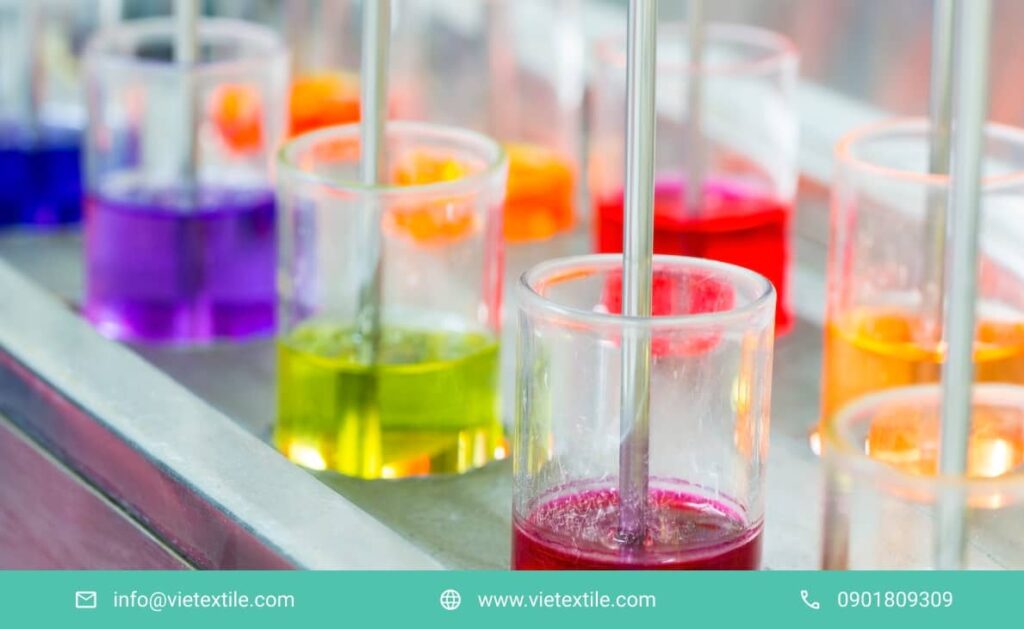
Reproducibility is the ability to achieve the same color in different dye batches. This is a vital factor in mass production.
7.1. Reproducibility of Powder Form
- Challenge: The reproducibility of powder Disperse Dyes depends on 3 manual steps: Weighing rightarrow Preparation rightarrow Dosing. Errors at any step (e.g., weighing errors due to moisture, dispersion errors due to insufficient stirring) will cause color differences between batches.
7.2. Reproducibility of Liquid Form
- Advantage: The liquid form is automatically dosed by a Dosing Pump. This system completely eliminates the human factor. The pump’s accuracy (which can reach pm 0.1 ml) ensures the Disperse Dye concentration is always precise according to the formula.
8. Environmental Impact and Wastewater Treatment Costs
Disperse Dyes, whether in powder or liquid form, pose environmental challenges.
8.1. Excess Dispersing Agent
The dispersing agent (Lignin Sulfonates) is a colorless organic substance, but it increases the COD (Chemical Oxygen Demand) content in the wastewater. Both powder and liquid forms contain dispersing agents, but the liquid form often has a more complex concentration of stabilizers.
8.2. Hydrolyzed/Excess Dye
The amount of Disperse Dye that hydrolyzes (does not fix to the fiber) will be discharged. The liquid form, with its superior suspension stability, minimizes the risk of dye particles flocculating into large clumps (Tarring) that can cause clogging and are more difficult to treat.
8.3. Long-term Cost of Ownership (LCO)
Although the powder form is cheaper, the liquid form reduces the Long-term Cost of Ownership (LCO) due to:
- Reduced Defects: The Re-dyeing rate is significantly reduced thanks to high reproducibility.
- Reduced Labor Costs: Automation optimization reduces preparation labor and setup time.
- Safety: Reduced personal protective equipment costs and health-related litigation risks.
9. Frequently Asked Questions (FAQ) About Disperse Dyes
1. Question: Why are Disperse Dyes insoluble in water but still used for dyeing in an aqueous environment? Answer: Disperse Dyes are insoluble but exist as a Suspension of ultrafine particles (< 1 micron) thanks to the Dispersing Agent. During the hot dyeing process, these particles dissolve into single molecules and diffuse into the fiber.
2. Question: What is the role of the 130C temperature in dyeing Polyester with Disperse Dyes? Answer: The 130C temperature (HTHP) is necessary to soften (plasticize) the polymer structure of Polyester, increasing the free space between the polymer chains. This allows the Disperse Dye molecules to diffuse deep into the fiber, where they dissolve and create fast colors.
3. Question: What is the biggest difference between powder and liquid Disperse Dyes regarding automation? Answer: The biggest difference is compatibility with the Dosing Pump System. The liquid form is preferred because it is fully stabilized, easy to pump and dose with high accuracy, eliminating human error. The powder form is prone to clogging and difficult to control moisture.
4. Question: Are there any occupational safety risks associated with powder Disperse Dyes? Answer: Yes. During the weighing and preparation process, powder Disperse Dyes generate fine dust that easily floats in the air. Inhaling this dust can cause respiratory irritation and other health issues, requiring strict dust extraction systems and protective equipment.
5. Question: How can I maintain the stability of liquid Disperse Dyes during storage? Answer: They should be stored in specialized containers, avoiding direct sunlight and excessively high or low temperatures. Most importantly, gentle periodic stirring or circulation is needed to prevent the Settlement of dye particles at the bottom of the container.
6. Question: Why is it necessary to control the pH to slightly acidic (pH 4.5-5.5) when dyeing with Disperse Dyes? Answer: Dyeing at a slightly acidic pH is to prevent the Hydrolysis of Disperse Dye molecules. In an alkaline environment (high pH), some color groups will decompose, leading to a change in color (color deviation) or fading.
7. Question: Is the dispersing agent still necessary for liquid Disperse Dyes? Answer: Yes. Whether in liquid or powder form, Disperse Dyes require a dispersing agent. In the liquid form, the dispersing agent is pre-added and stabilized during the wet milling process to ensure the dye particles do not flocculate even while they are in the storage container.
VieTextile provides dyeing technology solutions for Polyester, including automatic dosing equipment for liquid Disperse Dyes and spare parts for HTHP dyeing machines.
Contact Information:
Hotline: 0901 809 309
Email: info@vietextile.com
Website: https://vietextile.com

